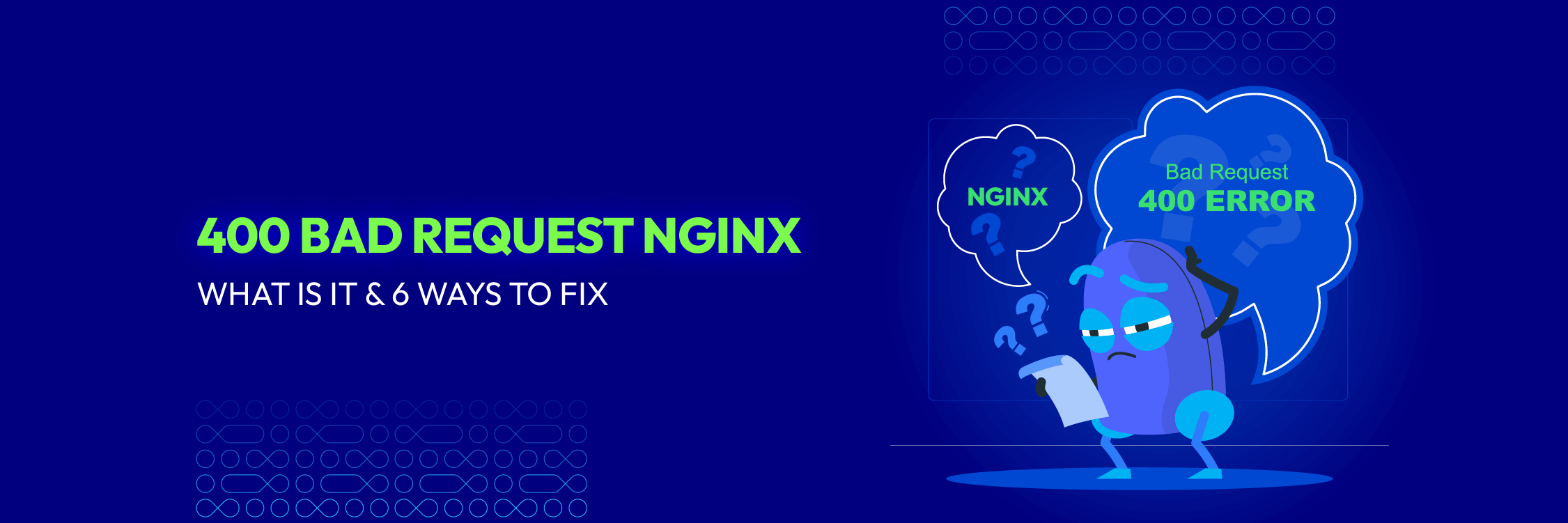400 Bad Request Nginx: What Is It & 6 Ways To Fix
Summer Nguyen | 12-15-2023

It is not unusual to run into issues while exploring the internet. The 400 Bad Request Nginx error is one such error that you may have encountered. Generally, website visitors and developers may find this error message frustrating.
However, recognizing the root causes and alternative remedies for this error can assist in resolving the situation and guarantee a seamless browsing experience.
We’ll examine the implications of the 400 Bad Request Nginx error, and its root causes and offer practical solutions to fix it effectively.
400 Bad Request Nginx Meaning
The 400 Bad Request Nginx error is a status code that indicates an issue with the client’s request, which prevents the Nginx server from processing it. If you encounter this problem, it signifies that the client’s request was delivered to the web server Nginx, which cannot comprehend or process it.
This error message is produced by the well-known open-source software Nginx when it gets an improper or invalid request from the client’s browser. Nginx software can also be used to build servers by server owners. Although it was made to be quick, it has also been employed as a reverse proxy or load balancer.

In other words, Nginx is a powerful application that reliably takes multiple connections at once. Therefore, if the Nginx server sends a 400 Bad Request error, the client’s headers exceed the Nginx cookie size limit.
Differentiate 400 Bad Request Nginx From Generic 400 Bad Request
The generic 400 Bad Request error and the 400 Bad Request Nginx error are identical in that they denote a faulty or incorrect request from the client.
The Nginx Bad Request error and other generic 400 Bad Request problems still have some common differences. The following details are available for your review:
- Server software: The server software responsible for producing the error is the primary difference. A generic 400 Bad Request problem can occur on any web server. However, the Bad Request 400 Nginx issue is exclusive to the Nginx web server.
- The message of the error: A 400 Bad Request Nginx error specifically refers to Nginx, indicating that the problem is with the server’s setup or how the server processes the request. However, a generic 400 Bad Request error does not offer details regarding the server software or the underlying issue.

- Steps to troubleshoot: The 400 Bad Request Nginx problem can be fixed by concentrating on Nginx-specific setups, reviewing server logs, and adjusting directives, as opposed to generic errors, which require general techniques for various web servers
- Community support: Since Nginx is a commonly used web server, there are groups, forums, and documentation devoted to discussing Nginx-related problems. Finding solutions suited to Nginx settings may be possible with the help of this expert support.
Read more: 400 Bad Request Cookie Too Large: What Is It & How To Fix
Causes Of The 400 Bad Request Nginx
Multiple factors might lead to the 400 Bad Request Nginx error, which normally denotes an issue with the client’s request. Some typical causes of the error include the following:
- Query string or malformed URL: The client’s request does not follow the syntax of the HTTP protocol or is formatted improperly. This might result from the request being incomplete or the HTTP methods being used incorrectly, such as manual typing errors, encoding problems, or improperly escaping special URL characters.
- HTTP request headers that are not legitimate: Nginx may reject your request with a Bad Request 400 Nginx error if the headers are too large for the server to handle. This may happen if the client transmits too many cookies or if the headers exceed the server’s set limit.
- Large request size: The size of requests that the Nginx server can process is constrained. The server may reject the request and provide an Nginx Bad Request error if the request is too large, such as when providing too much data or uploading large files.
- Expired or invalid cookies or browser cache: The cache or cookies of the browser may occasionally malfunction and result in the 400 Bad Request Nginx error. Incorrect cookie settings or outdated or damaged cached data can obstruct the request and result in an error.
6 Solutions To Fix The Ngnix Bad Request 400 Error
Depending on the primary causes for the error, which was discussed above, there are a number of potential solutions. You can follow these points to resolve the 400 Bad Request error in the Nginx server:
Check The URL And The Query String
You should review the client’s requested URL and query parameters. Additionally, look for missing or incorrect parameters in the client’s request. Keep in mind that the request should comply with the syntax of the HTTP protocol.

Double Check The HTTP Request Headers
You should check the request headers to make sure they are formatted properly. Incorrect or missing headers may cause a 400 Bad Request Nginx error code. Make that all necessary headers are present and correctly configured.
Reduce Request Size
Consider reducing the request size if you encounter errors when sending large files or a lot of data. To stay within the server’s restrictions, divide large files into more manageable portions or optimize the transmitted data.
Clear Cookies And Cache From Your Browser
Conflicts can be resolved by clearing the cookies and cache in the browser. Try using a different browser completely, or clear the cache and cookies associated with the troublesome page.
Inquire With The Website’s Administrator
It is advised to contact the website administrator or support staff if the error continues and you have successfully ruled out any client-side difficulties. They can look into the server-side configurations and offer detailed instructions on how to fix the problem.
Restart The Software And Contact Nginx Administrators
Remember to restart Nginx when you make any changes to the configuration file. After attempting these fixes, if the error still occurs, it may be preferable to contact knowledgeable Nginx administrators or developers who can identify and fix the exact problem on your server.
Conclusion
It can be irritating to receive the 400 Bad Request Nginx error message, but it is crucial to remember that this is frequently a client-side issue brought on by improperly formatted or invalid requests.
You can successfully troubleshoot and fix this error by comprehending the common reasons and putting the suggested fixes offered in this blog post into practice.
You may avoid getting the Nginx Bad Request 400 error and have a seamless surfing experience by ensuring your URLs are formatted correctly, validating your request headers, controlling the size of your requests, and taking care of any cookie and cache problems with your browser.






![Top 20+ Must-have Shopify Apps for 2025 [Free & Paid] - Mageplaza](https://cdn2.mageplaza.com/media/blog/must-have-shopify-apps/top-must-have-shopify-apps.png)
![[2025 Updates] Top 10+ Upsell Apps for Shopify - Mageplaza](https://cdn2.mageplaza.com/media/blog/best-upsell-shopify-app/cover.png)